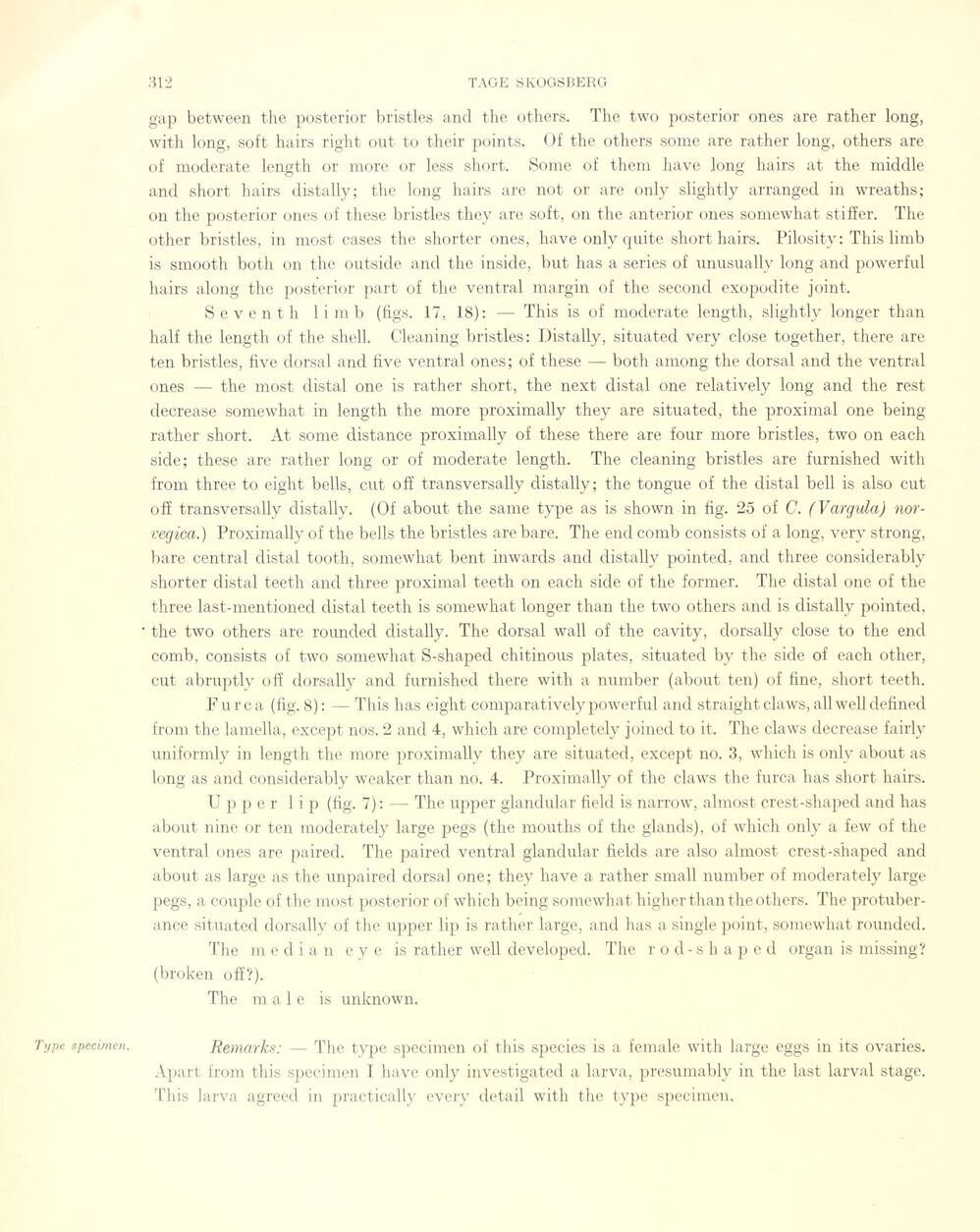
Full resolution (JPEG) - On this page / på denna sida - Sidor ...

<< prev. page << föreg. sida << >> nästa sida >> next page >>
Below is the raw OCR text
from the above scanned image.
Do you see an error? Proofread the page now!
Här nedan syns maskintolkade texten från faksimilbilden ovan.
Ser du något fel? Korrekturläs sidan nu!
This page has never been proofread. / Denna sida har aldrig korrekturlästs.
gap between the posterior bristles and the others. The two posterior ones are rather long,
with long, soft hairs right ont to their points. Of the others some are rather long, others are
of moderate length or more or less short. Some of them have long hairs at the middle
and short hairs distally; the long hairs are not or are only slightly arranged in wreaths;
on the posterior ones of these bristles they are soft, on the anterior ones somewhat stifïer. The
other bristles, in most cases the shorter ones, have only quite short hairs. Pilosity : This limb
is smooth both on the outside and the inside, but has a series of unusually long and powerful
hairs along the posterior part of the ventral margin of the second exopodite joint.
S event h limb (figs. 17, 18): — This is of moderate length, slightly longer than
half the length of the shell. Cleaning bristles: Distally, situated very close together, there are
ten bristles, five dorsal and five ventral ones; of these — both among the dorsal and the ventral
ones — the most distal one is rather short, the next distal one relatively long and the rest
decrease somewhat in length the more proximally they are situated, the proximal one being
rather short. At some distance proximally of these there are four more bristles, two on each
side; these are rather long or of moderate length. The cleaning bristles are furnished with
from three to eight bells, cut o ff transversally distally; the tongue of the distal bell is also cut
off transversally distally. (Of about the same type as is shown in fig. ’25 of C. (Vargvla)
norvegica. ) Proximally of the bells the bristles are bare. The end comb consists of a long, very strong,
bare central distal tooth, somewhat bent inwards and distally pointed, and three considerably
shorter distal teeth and three proximal teeth on each side of the former. The distal one of the
three last-mentioned distal teeth is somewhat longer than the two others and is distally pointed,
the two others are rounded distally. The dorsal wall of the cavity, dorsally close to the end
comb, consists of two somewhat S-shaped chitinous plates, situated by the side of each other,
cut abruptly ofï dorsally and furnished there with a number (about ten) of fine, short teeth.
Furca (fig. 8): — This has eight comparatively powerful and straight claws, all well defined
from the lamella, except nos. 2 and 4, which are completely joined to it. The claws decrease fairly
uniformly in length the more proximally they are situated, except no. 3, which is only about as
long as and considerably weaker than no. 4. Proximally of the claws the furca has short hairs.
Upper 1 i p (fig. 7) : — The upper glandular field is narrow, almost crest-shaped and has
about nine or ten moderately large pegs (the mouths of the glands), of which only a few of the
ventral ones are paired. The paired ventral glandular fields are also almost crest-shaped and
about as large as the unpaired dorsal one; they have a rather small number of moderately large
pegs, a couple of the most posterior of which being somewhat higher than the others. The
protubérance situated dorsally of the upper lip is rather large, and has a single point, somewhat rounded.
The m e d i a n e y e is rather well developed. The rod-shaped organ is missing?
(broken off?).
The male is unknown.
Remarks: — The type specimen of this species is a female with large eggs in its ovaries.
Apart from this specimen 1 have only investigated a larva, presumably in the last larval stage.
This larva agreed in practieaUy every detail with the type specimen.
Type specimen.
<< prev. page << föreg. sida << >> nästa sida >> next page >>